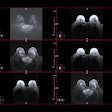
The imaging community is moving rapidly toward the adoption of analytics and artificial intelligence (AI). But are leaders making their AI investments wisely? Before answering that question, it's worth a look back to the era when vendor-neutral archives (VNAs) were initially deployed across the industry.
At that time, proprietary data silos were the norm. While the data within each silo worked well with dedicated applications, the speed of advancement in digital imaging technology was the impetus for implementing VNAs.
Untenable complexity
 Mitchell Goldburgh of NTT Data Services.
Mitchell Goldburgh of NTT Data Services.
Storing data on a VNA is a way of reducing the impact of change and increasing new technology adoption. Instead of requiring updates for multiple viewing and workflow applications and addressing complex integrations, the VNA offers one unified platform that is universal in supporting multiple workflows and clinical application access. Also, data migration is unnecessary when changing vendors.
Appropriately, the imaging community has adopted VNAs to eliminate data silos, simplify the IT environment, and increase exchange. It's been a significant improvement for the imaging community, as well as for physicians and other providers who need access to reports and images. In many cases, VNAs have facilitated the integration of imaging reports with physician electronic health records (EHRs), providing significant convenience for these providers.
Return of silos?
However, the advent of advanced analytics and AI is threatening to bring back silos. If healthcare organizations begin to use point solutions and proprietary applications and platforms for analytics, they will recreate the silo problem they just spent time, money, and effort eliminating.
A point solution may be able to solve an immediate problem, but it isn't likely to address the longer-term, strategic analytics needs across an enterprise. It will also become a nuisance to integrate these isolated systems with the enterprise imaging workflow; maintenance and updates will quickly become time-consuming chores for the IT department.
This problem is similar to those caused by vendor-specific viewing and workflow applications. Data analytics technology is advancing rapidly, and keeping current with the plethora of applications and platforms will soon become unwieldy and expensive.
Also, the lack of flexibility and adaptability in these point solutions will create gaps in analytic capability that can't readily be closed. For a fast-changing industry like medical imaging, that's a speed bump that will hurt patient care and organizational competitiveness.
VNAP: A more flexible approach
The alternative to point-based AI solutions is a vendor-neutral analytics platform (VNAP) that supports a variety of applications and tools, as well as the ability to integrate data independent of the source. Such a platform will accept data from any imaging source, leveraging standards and allowing for analytics capabilities to be utilized in the workflow.
Furthermore, new analytics and AI options can be added as the library of algorithms grows. This simplifies support and integration, enabling an organization to rapidly adopt these new tools as they become available. The ability to rapidly adopt new tools will be key to improving patient care, a critical task as healthcare providers and payors move quickly toward value-based reimbursement. The imaging service that can help meet the quality, cost, and patient experience goals of providers will be the service that survives this transition.
A vendor-neutral analytics platform also carries the advantage of being more adaptable and able to more easily expand and increase capabilities. For example, in the future, an organization may want to incorporate nonimaging data to enrich insights. An adaptable platform that uses all available data will more easily incorporate new data sources and new tools. And the results of the analyses will be easier to integrate with other applications as well, such as electronic health records.
An enterprise-wide approach also will facilitate future integration of clinical analytics results with operational analytics results, helping organizations better understand the interplay between operations and clinical outcomes.
Resist the temptation
While a point solution may look like a simple answer to a single problem, implementing AI in this manner actually adds complexity, cost, and unnecessary work in the future. Point solutions are at best a temporary stopgap -- and at worst a drain on critical resources.
Don't be distracted by this temptation, especially now that a vendor-neutral analytics platform is readily available and easy to adopt.
Mitchell Goldburgh is imaging solutions director at NTT Data Services.
The comments and observations expressed are those of the author and do not necessarily reflect the opinions of AuntMinnie.com.



















